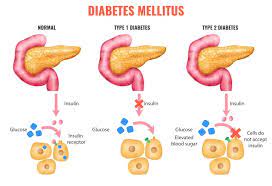I. Introduction
Diabetes: A Comprehensive Guide
Diabetes is a prevalent and complex health condition that affects millions of people worldwide. In this comprehensive guide, we will delve deep into the various aspects of diabetes, including its definition, causes, symptoms, treatment options, and types. Whether you’re looking to better understand your own condition or seeking knowledge to help a loved one, this article aims to provide valuable insights into diabetes.
II. Understanding Diabetes
- Definition of Diabetes:
At its core, diabetes is a chronic medical condition characterized by elevated levels of glucose (sugar) in the bloodstream. This occurs when the body cannot effectively regulate blood sugar due to a breakdown in the insulin production or utilization process.
- The Significance of Glucose:
Glucose serves as the primary source of energy for our cells. It’s essential for bodily functions, and its regulation is tightly controlled to maintain overall health.
- Role of Insulin:
Insulin, a hormone produced by the pancreas, plays a critical role in managing blood sugar. It acts as a key to unlock cells, allowing glucose to enter and be used for energy. When this process is disrupted, diabetes can develop.
III. Causes of Diabetes
- Genetic Factors:
Genetics can predispose individuals to diabetes. A family history of the condition may increase one’s risk.
- Lifestyle Choices:
Unhealthy lifestyle choices, such as poor diet and lack of physical activity, contribute significantly to type 2 diabetes.
- Autoimmune Factors:
In type 1 diabetes, the immune system mistakenly attacks and destroys insulin-producing cells in the pancreas.
IV. Symptoms of Diabetes
- Increased Thirst and Hunger:
Individuals with diabetes often experience excessive thirst and hunger as the body attempts to compensate for high blood sugar levels.
- Frequent Urination:
Excess glucose in the blood prompts frequent urination, leading to dehydration.
- Fatigue and Blurred Vision:
Diabetes can cause fatigue due to inefficient glucose utilization. It can also affect vision, leading to blurred eyesight.
- Slow Wound Healing:
High blood sugar can impair the body’s ability to heal wounds, making even minor injuries a concern.
V. Types of Diabetes
- Type 1 Diabetes:
Type 1 diabetes is an autoimmune condition that typically develops early in life. It requires lifelong insulin therapy due to the pancreas’s inability to produce insulin.
- Type 2 Diabetes:
Type 2 diabetes, often associated with lifestyle factors, is characterized by insulin resistance and impaired insulin production. It is more common in adults but can occur at any age.
- Gestational Diabetes:
Gestational diabetes occurs during pregnancy and usually resolves after childbirth. However, it can increase the risk of type 2 diabetes in the future.
- LADA (Latent Autoimmune Diabetes in Adults):
LADA is a less common form of diabetes that presents like type 2 but has an autoimmune origin. It progresses more slowly and may require insulin treatment.
VI. Diagnosis and Screening
- Blood Glucose Tests:
Blood glucose tests, such as fasting blood sugar and random blood sugar tests, help diagnose diabetes.
- Hemoglobin A1c Test:
The A1c test provides a three-month average of blood sugar levels and is a crucial tool in diabetes management.
- Oral Glucose Tolerance Test:
This test involves fasting overnight and drinking a sugary solution to assess how the body handles glucose.
VII. Treatment and Management
- Medications:
Various medications, including oral drugs and injectable insulin, are used to manage diabetes and control blood sugar levels.
- Insulin Therapy:
Insulin therapy is essential for type 1 diabetes and may also be required for type 2 and other forms of the condition.
- Lifestyle Changes (Diet and Exercise):
Healthy eating and regular physical activity play a pivotal role in diabetes management.
VIII. Complications of Diabetes
- Cardiovascular Problems:
Diabetes increases the risk of heart disease, stroke, and other cardiovascular issues.
- Kidney Disease:
Diabetic nephropathy can lead to kidney damage and, in severe cases, kidney failure.
- Nerve Damage (Neuropathy):
Diabetic neuropathy affects nerves, leading to pain, tingling, and numbness, often in the extremities.
- Eye Conditions (Retinopathy):
Diabetic retinopathy can cause vision problems and even blindness if left untreated.
IX. Prevention of Diabetes
- Healthy Eating:
Adopting a balanced diet rich in fruits, vegetables, and whole grains can help prevent type 2 diabetes.
- Regular Physical Activity:
Staying active and maintaining a healthy weight can reduce the risk of developing diabetes.
- Weight Management:
Achieving and maintaining a healthy weight is crucial for preventing and managing type 2 diabetes.
- Diabetes Awareness:
Raising awareness about diabetes and its risk factors can empower individuals to make informed choices about their health.
X. Conclusion
In conclusion, diabetes is a complex but manageable condition that requires vigilance and proactive care. Understanding its causes, symptoms, and types is essential for early diagnosis and effective management. With the right knowledge and lifestyle choices, individuals can lead fulfilling lives despite living with diabetes.











Leave a Reply